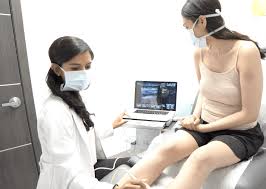Varicose veins are twisted, enlarged veins that usually appear on the legs and feet. They occur when the valves inside the veins stop functioning properly, allowing blood to flow backward and pool. This leads to visible swelling, bulging, and sometimes pain or discomfort. Though varicose veins may seem like a cosmetic issue to some, they can also indicate underlying circulatory problems and cause serious health concerns if left untreated.
What Symptoms Indicate That Varicose Vein Treatment Might Be Necessary?
Many people initially ignore varicose veins, especially if the symptoms seem minor. However, when individuals experience leg swelling, aching, throbbing, itching, or even skin ulcers, it becomes clear that the condition is more than skin-deep. Persistent discomfort, leg fatigue, skin discoloration, and open sores are signs that treatment may be not only helpful but also medically necessary.
What Type of Doctor Treats Varicose Veins?
A common question patients ask is, what type of doctor treats varicose veins? The answer is that vein specialists, also known as phlebologists, diagnose and treat vein-related disorders. These doctors often have backgrounds in vascular surgery, interventional radiology, or dermatology with specialized training in vein care.
At California Vein Treatment Center, patients receive care from board-certified vein specialists who use modern diagnostic tools and minimally invasive procedures to evaluate and treat vein conditions. These professionals work closely with each patient to determine the severity of the vein disease and the most appropriate course of action.
Is Varicose Vein Treatment Covered by Insurance?
One of the most important questions patients have is whether insurance will cover treatment. The answer depends on whether the insurance provider deems the procedure medically necessary or cosmetic.
Insurance companies usually classify treatments as medically necessary when a condition negatively affects a patient’s health or quality of life. In the case of varicose veins, insurance often provides coverage if the patient has documented symptoms such as:
- Persistent leg pain or discomfort
- Swelling or inflammation
- Skin changes or ulcerations
- Bleeding veins
- Evidence of venous reflux from diagnostic imaging
To obtain insurance coverage, patients typically must undergo a physical examination and duplex ultrasound. These tests document the presence of venous insufficiency and help determine the medical necessity of the procedure.
What Criteria Do Insurers Use to Approve Treatment?
Most insurers follow a detailed set of guidelines before approving varicose vein treatment. They may require the following:
- Clinical Documentation – Proof of symptoms and history of conservative treatments such as wearing compression stockings or elevating the legs.
- Ultrasound Imaging – A diagnostic ultrasound that confirms vein dysfunction or venous reflux.
- Failure of Conservative Measures – Documentation that symptoms persist even after non-invasive treatments.
- Physician Notes – Detailed notes from a specialist like those at California Vein Treatment Center explaining the necessity of the procedure.
Patients can increase their chances of insurance approval by consulting with an experienced vein specialist who understands how to document the medical need for treatment correctly.
When Is Varicose Vein Treatment Considered Cosmetic?
Insurance companies do not typically cover procedures done solely for cosmetic reasons. If the veins do not cause pain, swelling, or other complications, they are often considered an aesthetic issue. Spider veins, for instance, are smaller and usually don’t lead to medical problems. Treatments like sclerotherapy or laser therapy for spider veins are usually out-of-pocket expenses.
However, even cosmetic concerns can have emotional or psychological impacts. If the appearance of varicose veins causes significant distress, patients should still consult a specialist to discuss available options.
What Treatments Are Typically Covered by Insurance?
When deemed medically necessary, insurers may cover several minimally invasive procedures such as:
- Endovenous Laser Ablation (EVLA) – A laser fiber is inserted into the vein to seal it shut.
- Radiofrequency Ablation (RFA) – Heat from radiofrequency energy closes off the damaged vein.
- Sclerotherapy – A chemical solution is injected into the vein, causing it to collapse and fade over time.
- Microphlebectomy – Small incisions remove varicose veins close to the surface.
These procedures are often performed on an outpatient basis, requiring little recovery time. Specialists at the California Vein Treatment Center routinely perform these techniques with high success rates and excellent patient outcomes.
How Can the California Vein Treatment Center Help?
Choosing the right treatment facility is essential. The California Vein Treatment Center offers personalized care, state-of-the-art diagnostic tools, and a team of certified professionals. They provide thorough evaluations to determine whether your varicose veins meet insurance criteria for medical necessity.
Their team handles the insurance approval process, helping patients submit the required documentation and guiding them through each step. From initial consultation to post-procedure care, their goal is to ensure a comfortable and informed experience.
What Should You Expect During a Vein Treatment Consultation?
During your initial visit, the vein specialist will ask about your symptoms, review your medical history, and perform a visual exam of your legs. If necessary, they’ll schedule a duplex ultrasound to evaluate the veins beneath your skin. Based on the results, they will create a personalized treatment plan.
If you’re experiencing symptoms, make sure to describe them in detail. Your discomfort, work-related limitations, and quality of life all help determine whether insurance may cover the treatment.
How Can You Prepare for Insurance Approval?
To increase the chances of getting your treatment approved, consider these steps:
- Document Your Symptoms – Keep a record of when symptoms appear and how they affect your daily activities.
- Follow Conservative Treatments – Try wearing compression stockings, elevating your legs, and exercising regularly.
- Get a Diagnostic Ultrasound – This imaging confirms whether you have venous reflux or other complications.
- Work With a Specialist – Providers at California Vein Treatment Center are experienced in submitting the correct insurance documentation.
Why Should You Take Action Early?
Varicose veins may seem like a minor concern at first, but they can lead to more serious health issues over time. Untreated vein disease can result in skin ulcers, blood clots, and chronic venous insufficiency. By seeking treatment early and working with a qualified specialist, you reduce the risk of long-term complications.
Conclusion: Is Varicose Vein Treatment Medically Necessary?
So, is varicose vein treatment considered medically necessary by insurers? In many cases, yes—especially when the condition causes pain, swelling, or other health concerns. Insurance companies often require clear documentation of symptoms and diagnostic imaging, but they do approve procedures when medical necessity is proven.
Understanding what type of doctor treats varicose veins and choosing a trusted provider like California Vein Treatment Center will streamline the process and improve your chances of getting insurance approval. If you’re struggling with varicose veins, don’t wait. Schedule a consultation, document your symptoms, and take the first step toward healthier, more comfortable legs today.








